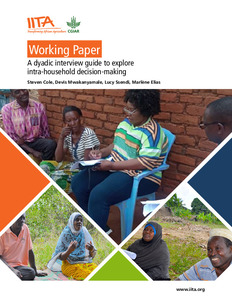| dc.contributor.author | Cole, S.M. |
| dc.contributor.author | Mwakanyamale, D. |
| dc.contributor.author | Ssendi, L. |
| dc.contributor.author | Elias, M. |
| dc.date.accessioned | 2021-12-21T11:43:49Z |
| dc.date.available | 2021-12-21T11:43:49Z |
| dc.date.issued | 2021-12 |
| dc.identifier.citation | Cole, S., Mwakanyamale, D., Ssendi, L. & Elias, M. (2021). A dyadic interview guide to explore intra-household decision-making. Ibadan, Nigeria: IITA, (45p.). |
| dc.identifier.uri | https://hdl.handle.net/20.500.12478/7300 |
| dc.description.abstract | Studies in the agricultural research for development literature that explore women’s involvement in decision-making within the household tend to focus their analysis on married or cohabiting couples and often consult only one spouse in a marital dyad during field interviews. These and other studies in the literature explore who makes a particular decision within the household, and more recently, inquire about the extent to which the respondent or another household member was involved in the decision-making process. Few studies investigate why decisions are made by one person or jointly or about the process used to make decisions within the household. Studies on intra-household decision-making frequently use quantitative tools (e.g., survey instruments) to collect data on who decides on a specific production or consumption matter within the household. In contrast, qualitative tools or mixed methods are more appropriate for uncovering how or why intra-household decisions get made. This working paper presents a review of the extant literature on intra-household decision-making, with a specific interest in describing the different methods and tools studies used to assess women’s and men’s involvement in decision-making within the household. The paper argues for using dyadic interviews as one qualitative method to explore intra-household decision-making. Dyadic interviews bring two participants together to interact and respond to open-ended questions that focus on their relationship as the site for which experiences making decisions takes place. To date, most qualitative or mixed-methods studies use focus group discussions or semi-structured interviews to explore decision-making within the household and separate spouses or organize women and men into sex-segregated groups during the interview or discussion process. The paper reviews the literature on dyadic interviews and presents and discusses the results from a study that developed and piloted a qualitative dyadic interview guide to help understand how and why decisions get made and explore, with some level of precision, the decisions that get made jointly or by only one spouse, and the contributions made by each spouse during a decision-making process. The guide could assist researchers in conducting in-depth interviews for a qualitative study or being part of a mixed-methods study to inform or nuance findings from the quantitative component on intra-household decision-making. |
| dc.description.sponsorship | CGIAR Research Program on Policies, Institutions, and Markets |
| dc.format.extent | 51 p. |
| dc.language.iso | en |
| dc.publisher | International Institute of Tropical Agriculture |
| dc.subject | Gender |
| dc.subject | Households |
| dc.subject | Decision Making |
| dc.subject | Women |
| dc.subject | Empowerment |
| dc.subject | East Africa |
| dc.title | A dyadic interview guide to explore intra-household decision-making |
| dc.type | Working Paper (Questionnaires, Templates, Field and laboratory documents, checklists) |
| cg.contributor.crp | Policies, Institutions and Markets |
| cg.contributor.affiliation | International Institute of Tropical Agriculture |
| cg.contributor.affiliation | Alliance of Bioversity International and the International Center for Tropical Agriculture |
| cg.coverage.region | Africa |
| cg.coverage.region | East Africa |
| cg.coverage.country | Tanzania |
| cg.coverage.hub | Eastern Africa Hub |
| cg.authorship.types | CGIAR Multi Centre |
| cg.iitasubject | Agronomy |
| cg.iitasubject | Capacity Development |
| cg.iitasubject | Food Security |
| cg.iitasubject | Gender |
| cg.iitasubject | Plant Breeding |
| cg.iitasubject | Plant Production |
| cg.iitasubject | Smallholder Farmers |
| cg.publicationplace | Ibadan, Nigeria |
| cg.accessibilitystatus | Open Access |
| cg.reviewstatus | Peer Review |
| cg.usagerightslicense | Creative Commons Attribution 4.0 (CC BY 0.0) |
| cg.targetaudience | Scientists |
| cg.futureupdate.required | No |

